
Linum (flax) is a genus of approximately 200 species in the flowering plant family Linaceae. They are native to temperate and subtropical regions of the world. The genus includes the common flax, the bast fibre of which is used to produce linen and the seeds to produce linseed oil.

Linum lewisii is a perennial plant in the family Linaceae, native to western North America from Alaska south to Baja California, and from the Pacific Coast east to the Mississippi River. It grows on ridges and dry slopes, from sea level in the north up to 11,000 ft (3,400 m) in the Sierra Nevada.
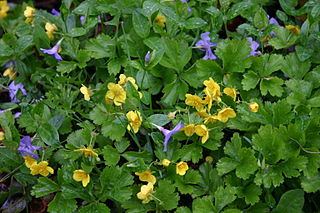
Waldsteinia fragarioides (syn. Dalibarda fragarioides Michx. and Geum fragarioides, also called Appalachian barren strawberry, or just barren strawberry, is a low, spreading plant with showy yellow flowers that appear in early spring. This plant is often used as an underplanting in perennial gardens.

Senna hebecarpa, with the common names American senna and wild senna, is a species of legume native to eastern North America.

Linum grandiflorum is a species of flax known by several common names, including flowering flax, red flax, scarlet flax, and crimson flax. It is native to Algeria, but it is known elsewhere in Northern Africa, Southern Europe and in several locations in North America as an introduced species. It is an annual herb producing an erect, branching stem lined with waxy, lance-shaped leaves 1 to 2 centimeters long. The inflorescence bears flowers on pedicels several centimeters long. The flower has 5 red petals each up to 3 centimeters long and stamens tipped with anthers bearing light blue pollen. It can on occasion be found as a casual well outside its normal established range; records from the British Isles, for example, are reasonably frequent but, grown as an annual, it rarely persists for more than one season.
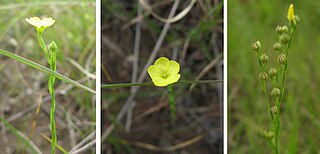
Linum medium, common name stiff yellow flax, is a species of Linum (flax) native to eastern North America. It is found as far west as Texas and Wisconsin, east to the Atlantic ocean, north to Ontario and Maine, and south to southern Florida. It is also found in The Bahamas.
Yellow flax is a common name for several plants in the flax family (Linaceae) and may refer to:
Bidens eatonii is a North American species of flowering plant in the daisy family. It is native to eastern Canada and the northeastern United States.

Solidago latissimifolia, common name Elliott's goldenrod, is North American species of flowering plants in the sunflower family. It is native to the Atlantic Coast of the United States and Canada, from Nova Scotia south to Alabama and Florida.
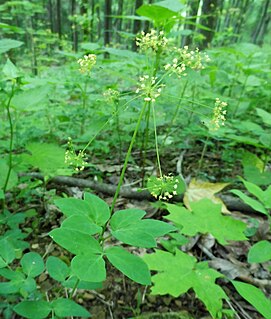
Taenidia integerrima, the yellow pimpernel, is an herbaceous plant in the parsley family. It is native to the eastern North America, where it is widespread. Its natural habitat is rocky prairies and woodlands, often over calcareous substrates. It is a perennial.
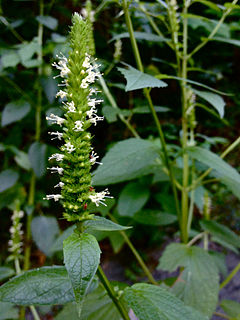
Agastache nepetoides, the yellow giant hyssop, is a perennial flower native to the United States and Canada. It is a member of the family Lamiaceae.
Linum intercursum, common names sandplain flax and sandplain wild flax, is a perennial plant native to the United States.
Linum arenicola, known as sand flax, is a flowering plant in the flax family, Linaceae. It is endemic to Florida in the United States, where it is considered an endangered species.

Dichanthelium scabriusculum common names tall swamp rosette-panicgrass, tall swamp panicgrass, rough panic-grass and panic grass, is a plant found in North America. It is listed as endangered in Connecticut, Maryland, and New York (state). It is listed as threatened in Massachusetts.
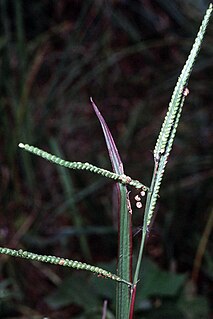
Paspalum laeve common name field paspalum, is a plant found in North America.

Panicum verrucosum, common name warty panicgrass, is a plant in North America. It is listed as a special concern and believed extirpated in Connecticut. It is listed as threatened in Indiana and Michigan, and as endangered in Ohio.
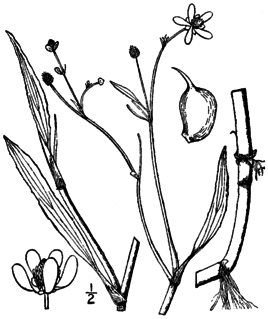
Ranunculus ambigens, common names water-plantain spearwort, water plantain, and spearwort, is a plant found in North America. It is listed as endangered in Connecticut, and New Hampshire, as endangered and extirpated in Maryland, as a special concern in Kentucky, as possibly extirpated in Maine, as threatened in Michigan, and as a special concern in Rhode Island.

Potamogeton hillii, common name Hill's pondweed, is a species of plant found in North America. It is listed as endangered in Connecticut, Ohio, and Pennsylvania. It is listed as a special concern in Massachusetts and as threatened in Michigan and New York (state).

Potamogeton vaseyi, common name Vasey's pondweed, is a species of plant found in North America. It is listed as an endangered species in Indiana, Massachusetts, and Pennsylvania, and is listed as threatened in Connecticut, Maine, Michigan, and New Hampshire, and as presumed extirpated in Ohio.

Cryptogramma stelleri, common names slender cliff-brake, fragile rock-brake, slender rock-brake, and Steller's rockbrake, is a plant found in North America. It is listed as endangered in Connecticut, Massachusetts, New Jersey, and Pennsylvania. It is listed as threatened in Maine and New Hampshire, as exploitably vulnerable in New York (state) and as sensitive in Washington (state).
















